If you think keeping your Suzuki motorcycle in top shape is as simple as adding gas, you're in for a surprise. Proper maintenance is vital for performance, safety, and longevity, yet many riders overlook some essential hacks. You might be surprised how a few straightforward tips can make a significant difference. From the right tools to seasonal checklists, mastering these maintenance hacks can save you time and money. Curious about what these hacks are and how they can elevate your riding experience?
Quick Takeaways
- Regularly check and maintain tire pressure to ensure safety and optimal performance while riding your Suzuki motorcycle.
- Use a quality torque wrench to tighten bolts to manufacturer specifications, preventing potential issues during rides.
- Lubricate your motorcycle chain every 300-600 miles to enhance performance and prolong its lifespan.
- Keep your battery clean and connections secure to avoid starting issues and ensure reliable electrical performance.
Essential Tools for Maintenance
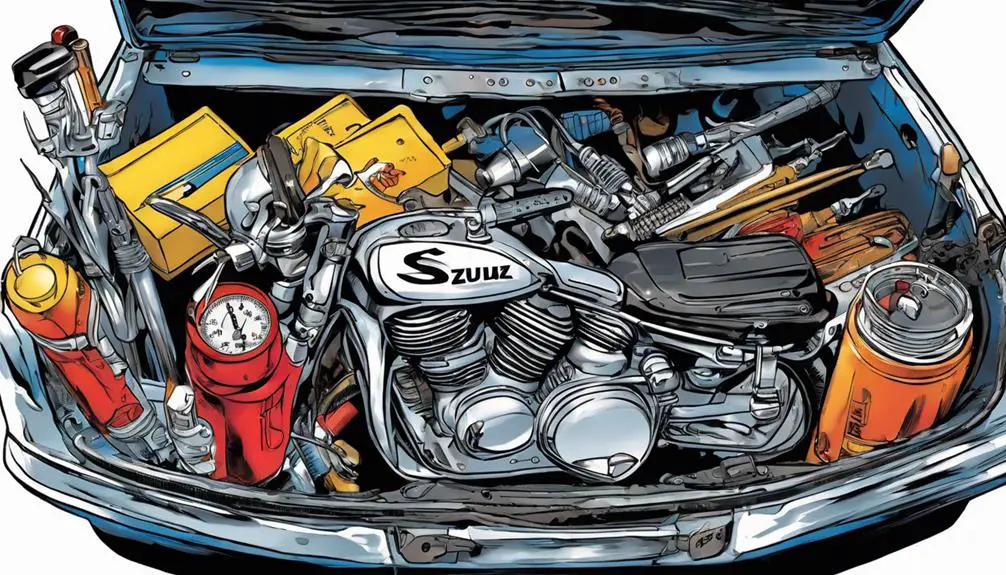
Having the right tools at your disposal can make Suzuki motorcycle maintenance a breeze.
Start with a quality set of screwdrivers—both flathead and Phillips. You'll need them for various tasks, from adjusting controls to removing panels. A torque wrench is another essential; it guarantees that bolts are tightened to the manufacturer's specifications, preventing issues down the road.
Next, invest in a reliable set of wrenches, including both metric and standard sizes. You never know when you'll need to tackle a stubborn bolt or nut. Don't forget a good pair of pliers; they're invaluable for gripping and twisting in tight spots.
A motorcycle jack or lift is vital for elevating your bike safely, allowing you to work comfortably without strain. Finally, a thorough tool kit specifically designed for motorcycles can simplify your maintenance routine.
With these tools in hand, you're not just maintaining your bike; you're empowering yourself. You'll gain confidence, understanding, and freedom as you navigate the world of motorcycle upkeep. Embrace the process, and enjoy the ride!
Regular Oil Change Tips
To keep your Suzuki motorcycle running smoothly, changing the oil regularly is crucial for maintaining engine performance. Neglecting this essential task can lead to increased wear and tear, ultimately compromising your ride.
By staying on top of oil changes, you not only enhance your bike's longevity but also guarantee a thrilling performance every time you hit the road.
Here are some tips to make your oil change experience seamless:
- Check the Owner's Manual: Always refer to your manual for specific oil change intervals and recommendations.
- Use Quality Oil: Invest in high-quality synthetic or semi-synthetic oil that matches your bike's specifications for peak performance.
- Warm Up the Engine: Before draining the oil, warm up the engine for a few minutes. This helps the oil flow out smoothly.
Chain Maintenance Made Easy
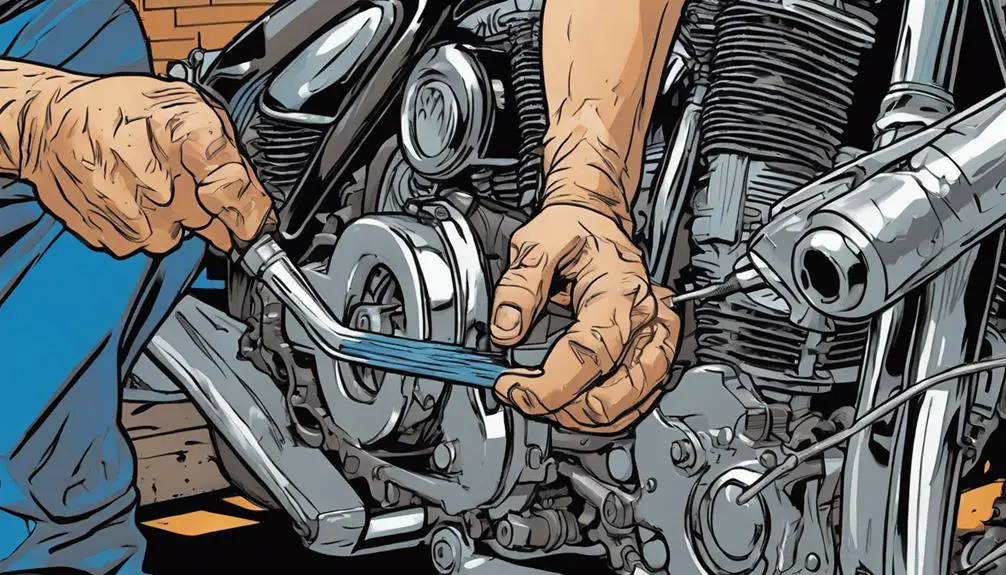
Keeping your chain in top shape is essential for a smooth ride.
You'll want to stick to a regular lubrication schedule and make sure the tension is just right.
Let's break down these easy steps to keep your Suzuki running efficiently.
Regular Lubrication Schedule
Regularly lubricating your motorcycle chain is essential for peak performance and longevity. A well-maintained chain not only enhances your riding experience but also guarantees your freedom on the road. Staying on top of lubrication will help prevent rust, reduce wear, and ultimately save you from costly repairs.
Here's how to create an effective lubrication schedule:
- Frequency: Lubricate your chain every 300-600 miles or after riding in wet conditions.
- Clean First: Always clean the chain before applying lubricant to remove dirt and debris.
- Use Quality Products: Invest in a good motorcycle-specific chain lube for best results.
Proper Tension Adjustment
Maintaining the right chain tension is just as important as regular lubrication for guaranteeing your Suzuki motorcycle runs smoothly and efficiently. An improperly adjusted chain can lead to premature wear, poor performance, and even safety issues. To keep your ride liberating and hassle-free, start by checking the tension regularly, ideally every couple of hundred miles.
To adjust the chain tension, first, place your bike on a level surface and check the slack by pushing the chain up and down in the middle section. The ideal slack generally falls between 1 to 2 inches, but consult your owner's manual for specific measurements.
If adjustments are needed, locate the rear axle adjusters on both sides of the swingarm. Loosen the axle nut, then turn the adjusters equally to guarantee the wheel remains aligned.
After adjusting, retighten the axle nut and check the tension again to confirm it's within the proper range. Regularly performing this simple maintenance task not only enhances your riding experience but also promotes the longevity of your bike.
Tire Care and Inspection
Taking care of your tires is essential for safety and performance.
You should regularly check the tire pressure, assess tread depth, and inspect for any visible damage.
Keeping your tires in top shape not only enhances your ride but also extends their lifespan.
Proper Tire Pressure
Proper tire pressure is essential for ensuring your Suzuki motorcycle handles well and delivers peak performance on the road. Riding with the right tire pressure not only enhances safety but also maximizes fuel efficiency and tire lifespan.
You want to know how to keep your tires in check? Here are some quick tips to help you maintain proper pressure:
- Check regularly: Inspect tire pressure at least once a month or before long rides.
- Use a reliable gauge: Invest in a quality tire pressure gauge for accurate readings.
- Follow manufacturer specs: Refer to your owner's manual for the recommended PSI for your model.
Tread Depth Checks
Checking your tire tread depth is just as important as monitoring tire pressure, as it directly impacts your motorcycle's grip and safety on the road.
When you're out there, conquering the open road, the last thing you want is to lose traction because of worn-out tires. Start by using a tread depth gauge or even a simple penny. Insert it into the tread; if you can see all of Lincoln's head, it's time to replace those tires.
Regular checks won't only keep you safe but also enhance your riding experience. Remember, a deeper tread offers better water displacement, reducing the risk of hydroplaning in wet conditions. It also improves handling and braking, giving you the freedom to ride with confidence.
Make it a habit to inspect your tires before long rides or at least monthly. If you're nearing the wear indicators, don't hesitate.
You deserve every ounce of performance your motorcycle can give you, and that starts with healthy tires. Embrace the road ahead, knowing you've got the grip to tackle whatever comes your way!
Visual Damage Inspection
A quick visual inspection of your tires can reveal any signs of damage, such as cuts, bulges, or uneven wear that could compromise your safety on the road. Taking a moment to check your tires not only keeps you safe but also enhances your riding experience. You deserve freedom on the open road, and ensuring your tires are in top shape is a vital step toward that liberation.
Here's what you should look for during your inspection:
- Cuts and Punctures: Look for any visible cuts or punctures that could lead to a flat.
- Bulges and Blisters: Check for any bulging areas, which indicate a weak spot that could blowout at high speeds.
- Uneven Wear Patterns: Inspect for uneven wear, suggesting alignment issues or improper inflation.
Regularly performing this visual damage inspection will keep you connected with your ride, empowering you to enjoy the journey without fear.
Brake System Upkeep
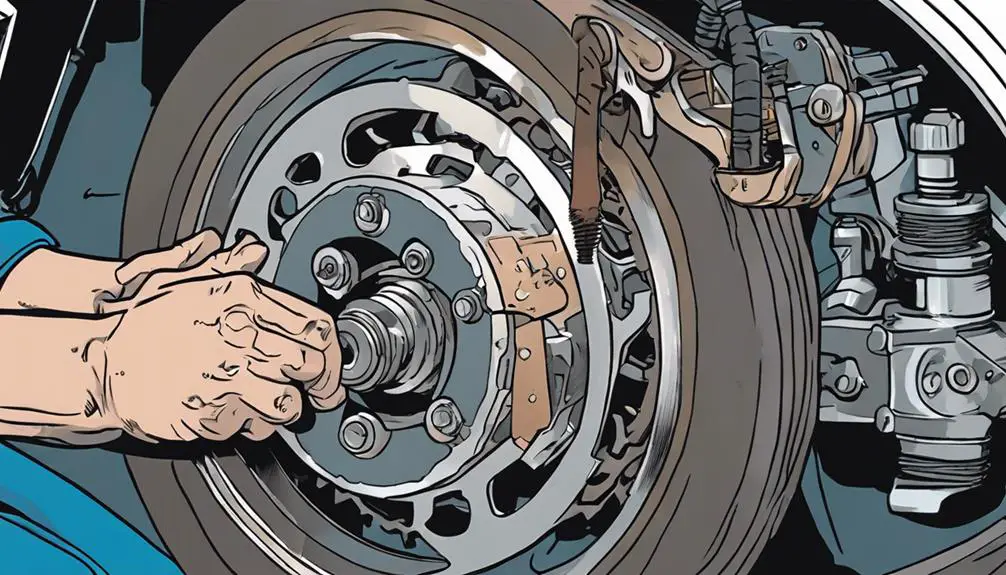
Maintaining your Suzuki's brake system is essential for safety and performance, so don't overlook regular inspections and fluid changes.
Start by checking your brake pads and discs for wear. If you notice any significant wear or unevenness, it's time to replace them. Squeaking or grinding sounds are clear signs you need to take action.
Next, inspect your brake fluid. Confirm it's at the proper level and hasn't become discolored or contaminated. If it looks murky, flush the system and refill with fresh fluid. Remember, the brake fluid absorbs moisture over time, which can lead to brake failure.
Pay attention to your brake lines too. Look for cracks or leaks, as these can compromise your braking power. If you spot any damage, replace the lines immediately.
Lastly, test your brakes regularly. Find a safe, open space and apply the brakes firmly to confirm they engage smoothly. If you feel any pulsing or hear unusual noises, get them checked out.
Electrical System Checks
Regularly inspecting your Suzuki's electrical system can prevent unexpected issues and guarantee a smooth ride. You wouldn't want a dead battery interrupting your freedom on the open road. Here's how to keep your electrical system in top shape:
- Check the battery: Verify it's clean and securely connected. Look for corrosion on terminals and clean it off if necessary.
- Inspect wiring and connectors: Look for frayed wires or loose connections that could lead to power loss or shorts. Tighten or replace as needed.
- Test the lights: Make sure all indicators, headlights, and taillights are working. Replace any burnt-out bulbs for visibility and safety.
Cleaning Your Motorcycle
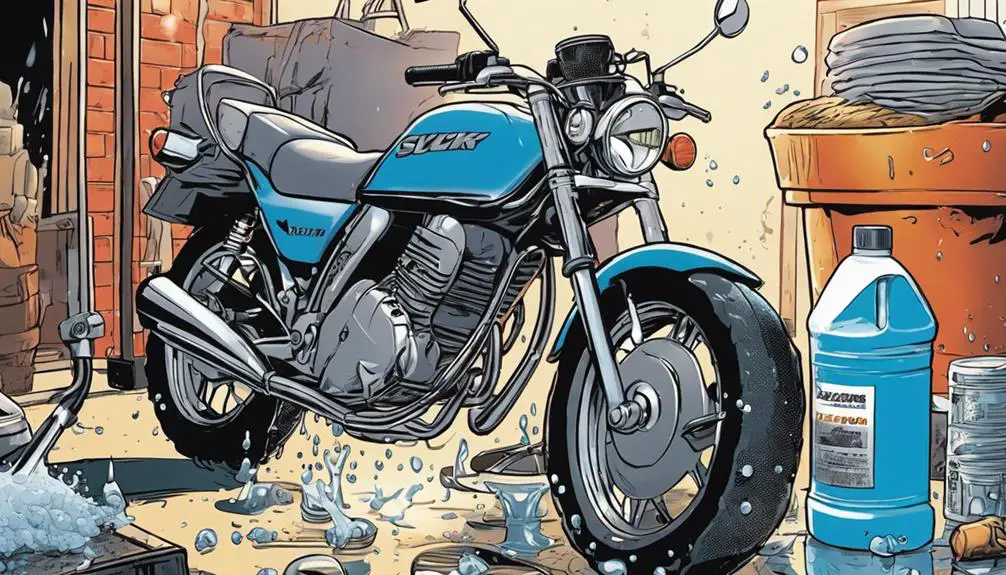
Keeping your Suzuki clean not only enhances its appearance but also helps preserve its components and performance over time. Start by gathering your supplies: a soft sponge, microfiber cloths, motorcycle-safe cleaner, and a bucket of water. Avoid harsh chemicals; they can damage your bike's finish.
Begin with the wheels and tires. Spray the cleaner on and let it sit for a few minutes before scrubbing with your sponge. Rinse thoroughly to keep brake components free from residue.
Next, move to the body of your motorcycle. Use a gentle spray to remove dirt and grime, then apply the cleaner with a soft sponge. Rinse off, ensuring no soap lingers.
Don't forget the chain! A clean chain helps maintain smooth rides. Use a brush and chain cleaner, and apply lubricant afterwards to keep it well-oiled.
Finally, wipe down your bike with a microfiber cloth to dry it and give it that shiny finish.
Regularly cleaning your Suzuki not only keeps it looking great but also helps you feel that liberating connection every time you hit the road. Your bike deserves the best, and so do you!
Seasonal Maintenance Checklist
As the seasons change, it's essential to give your Suzuki a thorough check-up.
Start by checking the tire pressure and inspecting fluid levels to guarantee everything runs smoothly.
These simple steps can make a big difference in your bike's performance and longevity.
Tire Pressure Check
Checking your tire pressure is essential for ensuring a smooth and safe ride, especially as the seasons change. Proper tire pressure not only enhances your bike's performance but also boosts your confidence on the road. When you ride with the right pressure, you're not just following a checklist; you're embracing the freedom of the open road with peace of mind.
Here's how to keep your tires in check:
- Use a reliable gauge: Always opt for a quality tire pressure gauge to get accurate readings.
- Check when tires are cold: Tire pressure can fluctuate with temperature, so measure when your bike hasn't been ridden for a while.
- Know your specs: Familiarize yourself with your Suzuki's recommended tire pressure, usually found in the owner's manual or on a sticker near the swingarm.
Fluid Level Inspection
Regularly inspecting your bike's fluid levels guarantees ideal performance and helps prevent potential issues down the road.
Check your engine oil, coolant, brake fluid, and clutch fluid to confirm everything's topped off and in good shape. For the engine oil, look for clarity and proper viscosity; dark, gritty oil can signal it's time for a change.
Next, check your coolant level. It should be between the minimum and maximum marks on the reservoir. Low coolant can lead to overheating, so it's essential to keep it topped up.
Don't forget about your brake and clutch fluids. These should be clear and at the right levels. If they're murky or low, it's time to change them; your safety depends on effective braking and smooth gear shifting.
Troubleshooting Common Issues
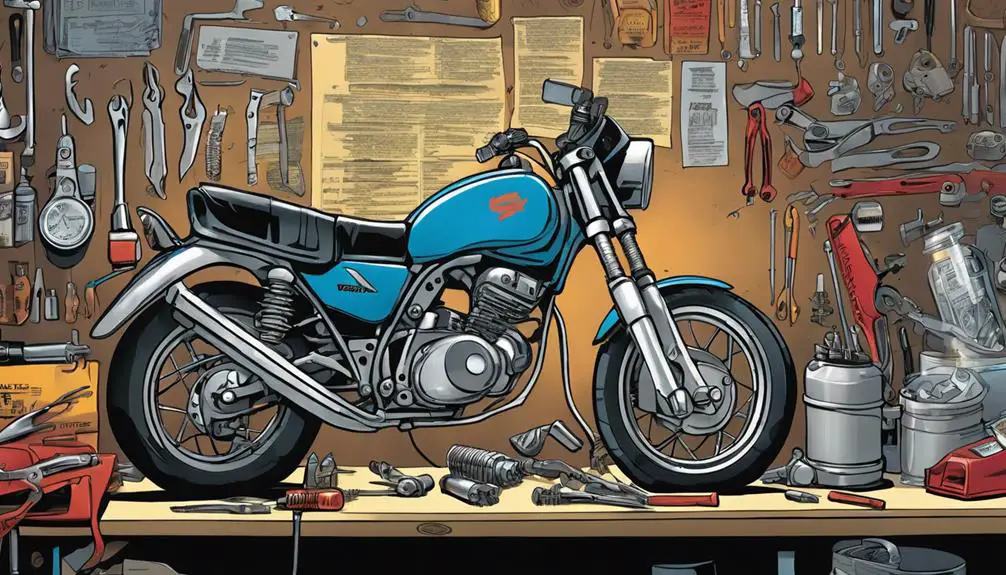
Identifying and resolving common issues with your Suzuki motorcycle can save you time and money in the long run.
Whether you're hitting the open road or cruising through the city, knowing how to troubleshoot can keep your ride smooth and exhilarating.
Here are a few common problems and their quick fixes:
- Starting Issues: If your bike won't start, check the battery and connections. A weak battery often leads to frustration.
- Engine Overheating: Inspect the coolant levels and radiator. Low coolant can cause overheating, so top it off.
- Brakes Not Engaging: Squeaky or unresponsive brakes may indicate worn pads or low brake fluid. Don't compromise your safety—address it immediately.
Joining Suzuki Communities
Connecting with fellow enthusiasts in Suzuki communities can enhance your riding experience and provide valuable insights for maintenance and upgrades.
These communities are treasure troves of knowledge, where you can learn from others' successes and challenges. By sharing your experiences, you not only gain confidence but also contribute to a culture of support and collaboration.
Whether you join online forums, social media groups, or local meet-ups, you'll discover a network of passionate riders ready to share tips, tricks, and hacks that can transform your Suzuki.
You'll find discussions on everything from routine maintenance to performance enhancements, allowing you to make informed decisions that elevate your ride.
Don't underestimate the power of camaraderie. When you engage with fellow Suzuki owners, you're tapping into a collective wisdom that can save you time, money, and frustration.
Plus, the friendships you forge can lead to unforgettable rides and adventures.
Common Questions
How Often Should I Replace My Motorcycle's Air Filter?
You should replace your motorcycle's air filter every 5,000 to 10,000 miles, but it really depends on your riding conditions.
If you ride in dusty or off-road environments, you might need to check it more frequently.
A clean air filter improves airflow, enhances performance, and boosts fuel efficiency.
Keeping an eye on it guarantees your ride stays smooth and powerful, so don't neglect this important maintenance step for your freedom on the road!
What Type of Fuel Is Best for My Suzuki Motorcycle?
When you're fueling your Suzuki motorcycle, you want to choose the right type of fuel for peak performance.
Most models run best on unleaded gasoline with an octane rating of 87 or higher. Check your owner's manual to confirm the specific requirements for your bike.
Using the right fuel not only enhances engine efficiency but also keeps your ride smooth and powerful, allowing you to experience the freedom of the open road fully.
Can I Use Car Oil in My Motorcycle?
Using car oil in your motorcycle is like trying to fit a square peg in a round hole; it just won't work.
While it might seem convenient, motorcycle engines require specific oil formulated for their unique demands.
Car oils often lack the necessary additives for proper lubrication and protection.
Stick with motorcycle oil to guarantee your ride runs smoothly and lasts longer.
Your bike deserves the best, so give it what it needs to thrive!
How Can I Improve My Motorcycle's Fuel Efficiency?
You can boost your motorcycle's fuel efficiency by keeping your tires properly inflated and ensuring your air filter's clean.
Regularly changing your oil and using the right fuel type also helps.
Try to maintain a steady speed and avoid heavy acceleration, which drains fuel.
Additionally, lighten your load by removing unnecessary items.
What Are the Signs of a Failing Ignition System?
If you're wondering about signs of a failing ignition system, look out for a few key indicators.
You might notice difficulty starting your bike, inconsistent engine performance, or stalling.
If you hear strange noises or see a decrease in fuel efficiency, that's a red flag too.
Additionally, check for a flickering check engine light or weak spark plugs; these can signal that your ignition system needs attention before it leads to bigger issues.
Wrapping Up
In the world of motorcycle maintenance, think of your Suzuki as a finely tuned instrument. Just like a musician wouldn't neglect their guitar strings, you shouldn't overlook your bike's needs.
Regular upkeep not only enhances performance but also deepens your connection to the ride. By embracing these ten hacks, you're not just preserving machinery; you're cultivating a relationship that fuels your passion for the open road.
So grab those tools, and let your Suzuki sing!